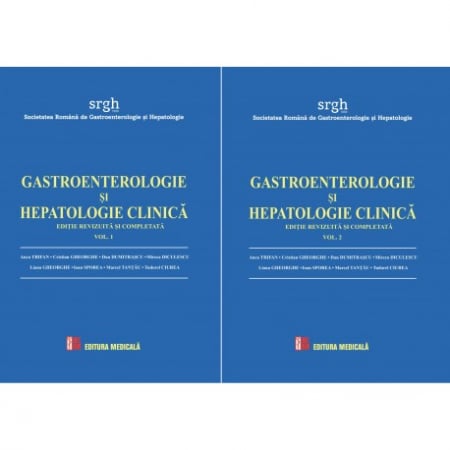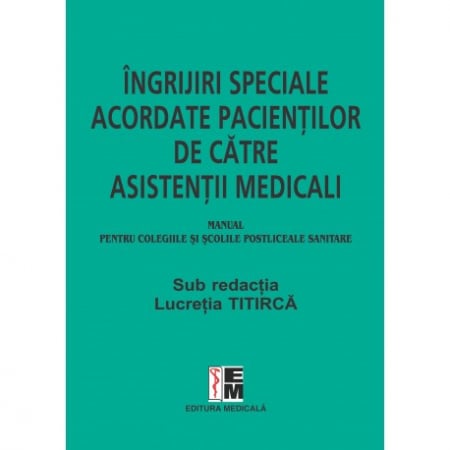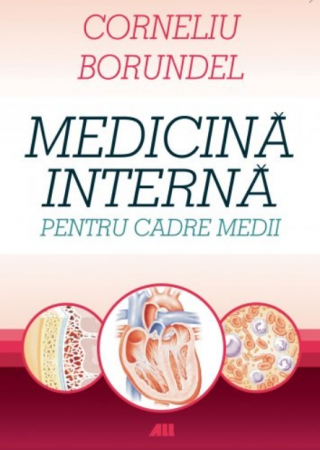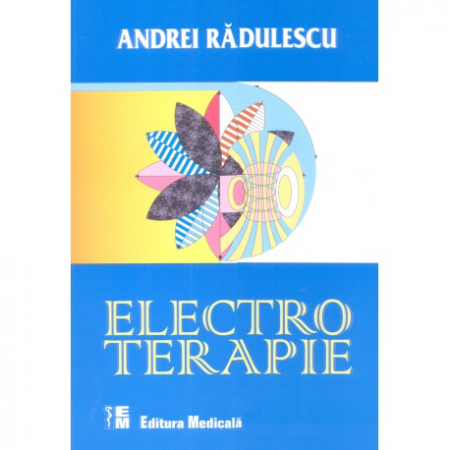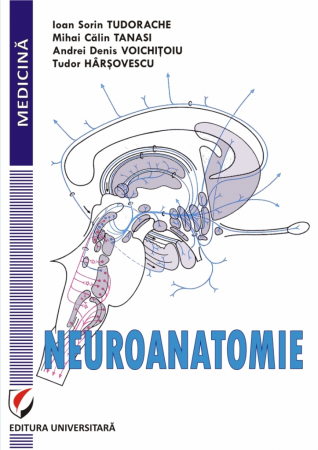ISBN: 978-606-28-0780-1
DOI: 10.5682/9786062807801
Publisher year: 2018
Edition: I
Pages: 192
Publisher: Editura Universitară
Author: Marina Otelea
- Description
- Download (1)
- Authors
- Content
- More details
- Reviews (0)
Cartea este dedicata in primul rand studentilor medicinisti, dar fiziologia si fiziopatologia sunt referinte universale in practica medicala, iar investigarea echilibrului acido-bazic este o componenta esentiala a evaluarii oricarui pacient cu o afectiune acuta, de gravitate medie sau severa; de aceea, intelegerea modului de functionare a acestei homeostazii apartine trunchiului comun de cunostinte fundamentale ale oricarui medic.
Marina Otelea
-
Fiziologia si fiziopatologia echilibrului acido-bazic
Download
1. Introduction / 9
2. Buffer systems / 14
2.1. Henderson Hasselbalch theory. The role of the bicarbonate buffer system / 14
2.2. Hemoglobin buffer system / 17
2.3. Phosphate buffer system / 20
2.4. Protein buffer system / 20
2.5. Bone carbonate buffer system / 22
3. Stewart physico-chemical theory / 23
3.1. Plasma SID / 23
3.2. Plasma anionic charge / 24
4. The role of the lung in the acid-base balance / 27
5. The role of the kidney in the acid-base balance / 32
5.1. Bicarbonate reabsorption and regeneration / 33
5.2. Titratable acidity / 37
5.3. Ammonium buffer system / 39
5.4. B / 42 type intercalated cells
6. Integration of acid-base balance with hydroelectrolytic balance / 44
6.1. The influence of water variations on the acid-base balance / 44
6.2. The influence of potassium variations on the acid-base balance / 48
6.3. The influence of chloremia variations on the acid-base balance / 51
The acid-base balance is determined by the concentration of H+ ions, being the result of the interaction of the components that produce H+ ions (acidic substances) with those that bind H+ ions (basic substances).
Since the plasma concentration of H+ ions is very low (0.00004 mEq / l), the acid-base balance is expressed by the pH value. By definition, the pH of a solution is equal to the logarithm with the changed sign of the activity of hydrogen ions in the solution, expressed in absolute value.
pH = - log [H + concentration]
In medical practice, arterial pH is measured. Therefore, in the absence of additional specifications, the notion of pH will refer in this manual to arterial pH; Cellular pH is generally more acidic (7.05) and varies depending on tissue type and metabolic activity (Awati et al, 2014).
The physiological variations of the arterial pH are in the range 7.35 - 7.45. The physiological ratio H2CO3/HCO3 in the blood is 1:20, the balance of the reaction being located in the slightly alkaline pH zone (7.4). Because pH is a logarithm of the H+ concentration, the pH variation (number of units of variation) is not identical to the variation of the H+ concentration; the variation of the H+ concentration is greater at the decrease of the pH than at the corresponding increase of the pH. For example, an increase in pH by 0.2 pH units (from 7.4 to 7.6) reflects a decrease in H+ concentration by 15 nEq / l from normal, while an identical variation of pH units, but in the opposite direction (decrease by 0.2 pH units), reflects an increase in the H + concentration of 23 nEq / l.
Most H+ ions in the body come from the cellular metabolism of organic compounds (proteins, lipids, carbohydrates) that generate volatile acids (CO2) and non-volatile. The diet of modern man generates, through a normal metabolism, between 50-100 mEq / day of non-volatile acids and approximately 15000 mmol of CO2 / day (Emmett M and Szerlip H, 2018).
CO2 is the end product of aerobic metabolism and, in the absence of a lung pathology, is eliminated by the respiratory tract. About 2/3 of the CO2 is transported to the lungs by red blood cells; the rest is dissolved in plasma (Arthurs and Sudhakar, 2005). CO2 has a very good transfer capacity through cell membranes, so the blood level is quickly balanced with both alveolar and intracellular. This has a positive consequence in their lung elimination. At the same time, the intracellular effects of a change in CO2 partial pressure (either an acidosis or a respiratory alkalosis) will set in faster than those of metabolic acid-base imbalances.
Non-volatile acids are metabolic products that cannot be degraded to CO2 such as, for example: uric acid, oxalic acid, glucuronic acid, hippuric acid. Non-volatile acids will be excreted in the urine, especially in the form of their conjugate bases (organic anions).
In addition to non-volatile acids, the degradation of proteins containing phosphorus or sulfur releases phosphoric / sulfuric acid (non-volatile acids) into the extracellular space, which is also eliminated in the urine. Sulfuric acid comes from oxidized cysteine and methionine residues; it is excreted as SO4 in the urine. Phosphoric acid is formed mainly from phospholipids.
The main endogenous basic component is H3CO-, but there are also food sources of alkalis (acetate, lactate, citrate, etc.), especially vegetables and fruits. Under physiological conditions, the reduced variations in pH values are due to the intervention of buffer systems that control blood pH, the elimination of CO2 at the respiratory level and the elimination of non-carbonic acids at the renal level.
As already mentioned, acids are substances capable of releasing H+. The release of an H+ dissociates the acid into a base and an H+ ion. The acid can be weak or strong, depending on the number of H+ ions released by dissolving (reaching equilibrium) in the water. For example, hydrochloric acid (HCl), lactic acid, ammonium ion (NH4) are completely ionized in water, being considered strong acids, while carbonic acid is incompletely ionized, being labeled as a weak acid.
HCl ↔ H+ + Cl
H2CO3 ↔ H+ + HCO3
Lactic acid ↔ H+ + lactate
NH4+ ↔ H+ + NH3¯
Bases are substances capable of accepting H+. Like acids, bases can be strong or weak. For example, Na+ hydroxide (NaOH) is a strong base and ammonia is a weak base.
NaOH + H2O ↔ NA+ + OH- + H2O
NH3+ + H2O ↔ NH4+ + OH¯
A weak base and a weak acid form a buffer system, which opposes pH changes.
Carbon dioxide and bicarbonate (HCO3) are the extracellular buffer system involved, according to Hasselbalch's theory (see below) at the heart of changes in acid-base balance. Any buffer system has an equilibrium pH called pKa (negative logarithm of dissociation constant) which is numerically equal to the pH of the system at which the two components (acid and anion) are present in
equal concentrations. For the HCO3 / CO2 buffer system, pK is 6.1, which is equivalent to saying that at a pH of 6.1, the ratio of HCO3 / CO2 concentrations is equal to 1.
The titration curve of a buffer system is sigmoidal in shape, and the straight line of this sigmoid (maximum efficacy in relation to the variation of pH) is located between 1 unit of pH minus and 1 unit of pH in addition to pKa (pKa + 1). In other words, the maximum activity of the buffer system of bicarbonate is located between 5.1-7.1. Also, from the pK level of 6.1 it can be concluded that, at a normal blood pH, the total amount of basic compounds of the buffer system is higher than that of acidic compounds.
For the phosphate system, whose pK is 6.8, the maximum efficiency corresponds to a pH between 5.8-7.8. Therefore, the phosphate buffer system is very effective at pH variations of the human body.
The maximum pathological variations (compatible with survival) of the pH are between 6.9 and 7.8. The closer the pH value is to the extremes of these values, the lower the chances of survival and the shorter the time to restore balance. The shift of the pH balance to the left (towards lower pH values), occurs through a deficit of bases or by excess of acids, and the shift to the right, occurs through an excess of bases or by deficit of acids.
It is important to note that there is no single, linear correspondence between blood and intracellular pH. The latter is regulated by the summed effects of O2 intake, the substrate of energy metabolism, metabolic activity, CO2 diffusion, the activity of proton transporters and anion exchangers (which also mediate the exchange of HCO -).
Defense systems against changes in blood pH intervene in a chronological order. The first line of defense is represented by the buffer systems, the most important being the buffer system of bicarbonates, phosphates and proteins. The second line of defense is represented by the respiratory mechanism, which intervenes in the homeostasis of pH through the excretion of CO2, being a type of rapid intervention (seconds). Subsequently, the renal mechanism intervenes, by modifying the excretion of H + coupled with the retention of HCO3 and by the buffer systems that act at this level (of phosphates and ammonium). The mechanism of renal intervention is slow (the maximum effect occurs in 24-48 hours), but much more effective than the respiratory one.
Compensation for acid-base balance disorders is performed by the kidneys and lungs. The compensatory mechanism is the response of the kidney or lung to the change in pH when they are not the organ that generates the change in pH. Thus, in primary respiratory disorders, compensation is achieved at the renal level and in primary metabolic disorders, compensation occurs through the respiratory system.
It is called the corrective mechanism, the response of the kidney or lung when they are the very organ that generates the primary disorder; even if the dysfunction of these organs is the cause of the imbalance, and at their level there are changes dependent on the variation of the plasma pH that can influence the acidemia or alkalemia. In primary respiratory disorders, these changes refer to changes in the frequency and / or amplitude of breathing and the elimination of CO2. In primary metabolic disorders, the production or elimination of nonvolatile acids is altered. If production changes, the kidney is not primarily affected and the renal mechanism is, in fact, also a compensatory mechanism. If the pathogenic element is concerned with the elimination of acids or bases in the kidneys, the kidney will have only a corrective role, which tries to limit the acid-base disorder; the corrective effect will be much lower than in the clinical contexts in which it acts as the seat of the compensatory mechanisms.
The intervention of the respiratory compensatory mechanism is rapid, but the possibilities of compensation are limited. Renal intervention is also initiated relatively quickly, but reaches a maximum only after 12 hours (in case of elimination of excess bases) and after 48 hours (in case of elimination of excess acid). The rate of increase in the elimination of bases is much steeper than that of the increase in the elimination of acids; practically, in the first 24 hours, the increase of acid elimination is very slow and becomes significant only after one day from the onset of acidemia.
The third line of defense against pH changes are intracellular buffer systems. At the cellular level, enzymatic activity is dependent on pH and can act to compensate for the imbalance. For example, phosphofructokinase activity is decreased by an acidic pH and accentuated by an alkaline pH. As this enzyme is essential for glycolysis, it results that, under conditions of intracellular alkalosis, glycolysis will be accelerated, with the increase of lactic acid formation, which will contribute to the decrease of intracellular pH. In lactic acidosis, inhibition of phosphofructokinase will act as a compensatory mechanism for lactic acid growth. Another example is renal glutaminase, which is activated by acidic pH, with increased NH3 formation and acid excretion through the ammonium buffer system and is inhibited in alkalosis (with decreased acid excretion). In chronic changes, calcium carbonate, as will be described below, plays an important role.

6359.png)
![Physiology and Pathophysiology of Acid-Base Balance - Marina Otelea [1] Physiology and Pathophysiology of Acid-Base Balance - Marina Otelea [1]](https://gomagcdn.ro/domains/editurauniversitara.ro/files/product/large/fiziologia-si-fiziopatologia-echilibrului-acido-bazic-256-520426.jpg)




